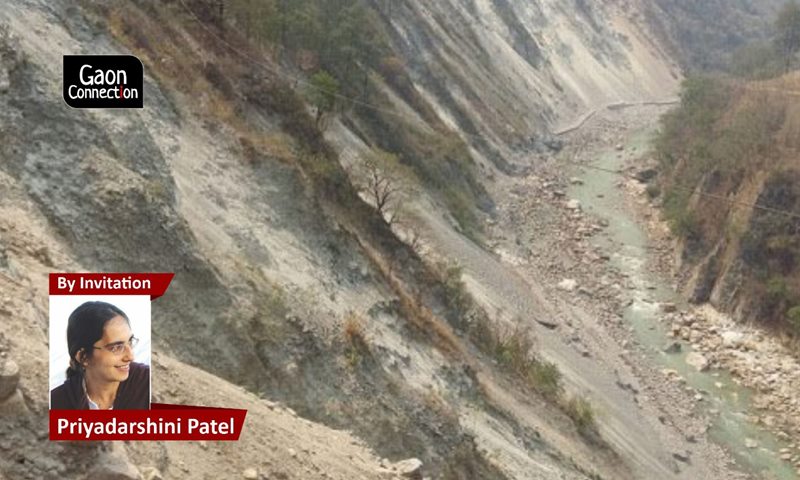It is the end of the monsoon season in Uttarakhand, and there is havoc in the mountains. Videos of road collapse, landslides, crashing protection walls, breached muck dump sites and entire mountain slopes sliding down with spectacular regularity are circulating on social media almost daily.
Possibly, for the first time in the history of Uttarakhand, on August 27 last month, the district magistrate of Tehri issued an order declaring the 80 kilometres (km) stretch from Tapovan to Maletha completely closed, as it was unsafe for commuters due to falling debris, boulders and collapsing ‘protection’ walls.
This stretch of the road is a part of a completed section of the Char Dham Pariyojana (CDP), widened to double lane with paved shoulder (DL+PS in engineering parlance), flush with retaining walls, and tarred. However, after a heavy spell of rain, 18 landslides were reported on the same day (August 27), on this 80 kms stretch alone; the detour to reach Rishikesh from Maletha was an additional 160 km, for civilians and army alike.
Also Read: Torrential rains, rivers-in-spate and landslides leave Uttarakhand in troubled waters
Even today, movement on this stretch of the completed Char Dham road is restricted and unreliable. A similar order of closing down the completed 50 km Narendranagar–Chamba CDP stretch was issued.
But why is it that ‘completed’ stretches of the much-publicised Char Dham project, an under-construction express national highway meant to connect four pilgrimages – Kedarnath, Badrinath, Yamunotri & Gangotri, have been shut for traffic?
To understand that, let us go back to 2016.
Char Dham project
On December 16, 2016, a government press release by the Union ministry of road transport and highways, stated that the Char Dham Pariyojana is a Rs 12,000 crore road widening project, of the already existing tarred road that connects the four Himalayan dhams in Uttarakhand.
The project was widely publicised as an ‘all-weather road’. But that tag is meaningless, as time has proved that the earlier existing road, with more stable slopes and fewer landslides, was much more of an ‘all-weather road’ than the new one ever was.
It is no secret that these fragile Char Dham valleys, rich in forests and glaciers, and source of life-giving rivers, are overburdened.
The project to build wider roads was meant to increase traffic inflow to the Char Dham. However, according to a high power committee, the dhams were already at the saturation point of tourist inflow. For instance, at 5,000 visitors a day, the temple town of Badrinath had reached its utmost carrying capacity.
Citizens protest and approach the court
When the Char Dham Pariyojana was announced, concerned citizens questioned the wisdom of widening the road sometimes up to 10 metres (m) in the steep terrain, and they filed a petition in the apex court in October 2018.
The Supreme Court responded to this and formulated a High Powered Committee (HPC) in August, 2019 to review the blanket-widening by the Char Dham project. The committee of 26 members was made up of government employees and four independent experts.
When concerns were raised by petitioners in court, before the thoughtless vertical cutting of the Himalayas commenced, the Union ministry of defence rebutted them in the following statement filed on February, 2021: “The Appellant has made various allegations and provided photographs of landslides in the Himalayan region. In response the answering respondent is providing photographs of landslide mitigation works and techniques… This would show that by undertaking appropriate works to ensure that further landslides do not occur in the areas where the roads have been constructed/widened, it is possible to have disaster resilient roads which are double laned.”
Thereafter, 56 pages of photographs and diagrams followed and the rebuttal concluded with, “It is evident from above pictures that vulnerable locations are already being treated with specialised protection measures. Additional/fresh sites are being investigated and appropriate measures taken to make roads disaster resilient.”
However, as per the road ministry, more than 200 landslides have been triggered on the Char Dham road since the work on the project commenced.
Instead of explaining and taking responsibility for the collapse, disagreement and warnings by those in the high powered committee against such a wide road, tree felling and tampering with the slopes, were dismissed as ‘unfortunate’ and ‘anti-national’ by the government.
‘Treating’ landslides
One of the landslide treatment projects at Badeti in Uttarkashi cost Rs 28 crore. The treatment method adopted by the road ministry in 2020 triggered a slope- collapse and the site became even more vulnerable. This after several crores of public funds had already been spent on it.
It was then decided that an open tunnel could be built costing another Rs 28.3 crore. But, even as pillars were being erected, the slope collapsed under the road, towards the valley. Outraged, a former MLA, demanding a high level inquiry into this open loot of government funds through faulty works, wrote to the district magistrate, demanding the culprits be punished.
This is not all. The completed 40-km long and eight- metre high protection wall on the DL+PS Chinnayalisaur bypass, built to sustain the vertically sliced slope, collapsed onto the highway in the course of just one monsoon, which means more public funds went down the drain, not to mention the danger it posed to human lives.
Also Read: Mayhem in May as Uttarakhand has episodes of back-to-back intense rainfall
The instances of landslides and slope failures due to vertical cutting to widen roads, are too numerous to enumerate. Even the three feeder highways of the Char Dham Pariyojana, leading to the border, were closed for days and weeks.
On NH-125 at Swala, Bartoli and Dhaun ghats, there were massive landslides that caused the road to be closed several times for several days. These stretches which were already sensitive have become critical after slope cutting.
On NH-58 Narkota, Lambagarh, Baldoda had fresh landslides this year, post cutting for the highway project. NH -94, NH-58 and NH-125 are all feeder roads to the Indo-China border and they were closed for many days, and required long detours.
Eco-sensitive zone affected
The Char Dham Pariyojana also runs through the Bhagirathi Eco Sensitive Zone (BESZ). This Himalayan valley, birthplace of the Ganga, has the beautiful rolling meadows of Dayara bugyal (meadow).
A proposed ski lift to the rolling meadow is being proposed despite numerous studies detailing the vulnerability of the site. Two years ago cracks developed on the surface of this vast meadow, but yet ‘development’ projects march blithely on.
In these secluded, floating landscapes, where traditionally, local inhabitants do not even walk with shoes in reverence, helicopters of guests arrive for lavish destination weddings that leave behind tonnes of garbage.
Even in this ‘notified’ eco zone, a road was being constructed by the irrigation department between Syaba and Baiyna villages that clearly lie in the BESZ. Clearances were obtained, construction began and an entire deodhar forest was felled before a local inhabitant enquired into the matter, and only then did the road ministry wake up to the fraudulent ‘project’. The half-built project is now suspended, temporarily.
The half completed Char Dham Pariyojana stands as a monumental failure today, a colossal mishap that has caused irreversible damage to the Himalaya. Yet, even after chronic landslides, slope failures, two hundred deaths and colossal expenditure, the government still refuses to retract on its DL+PS design.
Also Read: “This 900KM Himalayan Road Doesn’t Have Any Environmental Permissions!”
The HPC set up by the apex court was split on the core issue of a narrower intermediate width road versus the wider double lane paved shoulder. The chairperson and four independent experts held that the intermediate width was best suited for the terrain as well as sufficient for smooth traffic flow.
However, the 13 member majority composed entirely of government representatives voted for the wider road. This led the chairperson to submit the matter to the Supreme Court for final adjudication.
Meanwhile, even as that crucial verdict is awaited, no one has been held accountable for this Himalayan blunder.
To root out the menace once and for all, the Char Dham valleys should immediately be declared as eco zones modelled on the Bhagirathi eco zone; which then can be replicated across the Himalayas.
Priyadarshini Patel is the head member of Ganga Ahvaan, a citizen forum working towards conservation of the Ganga and the Himalayas. Views are personal.


















